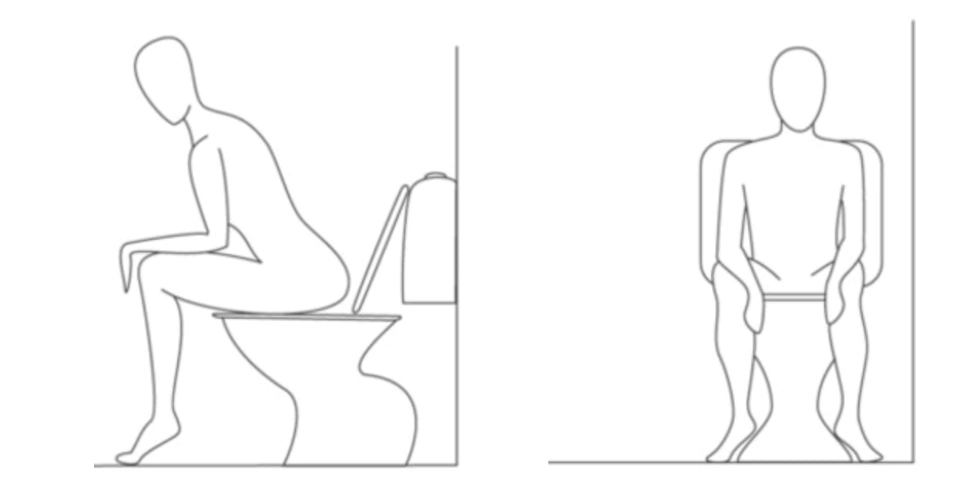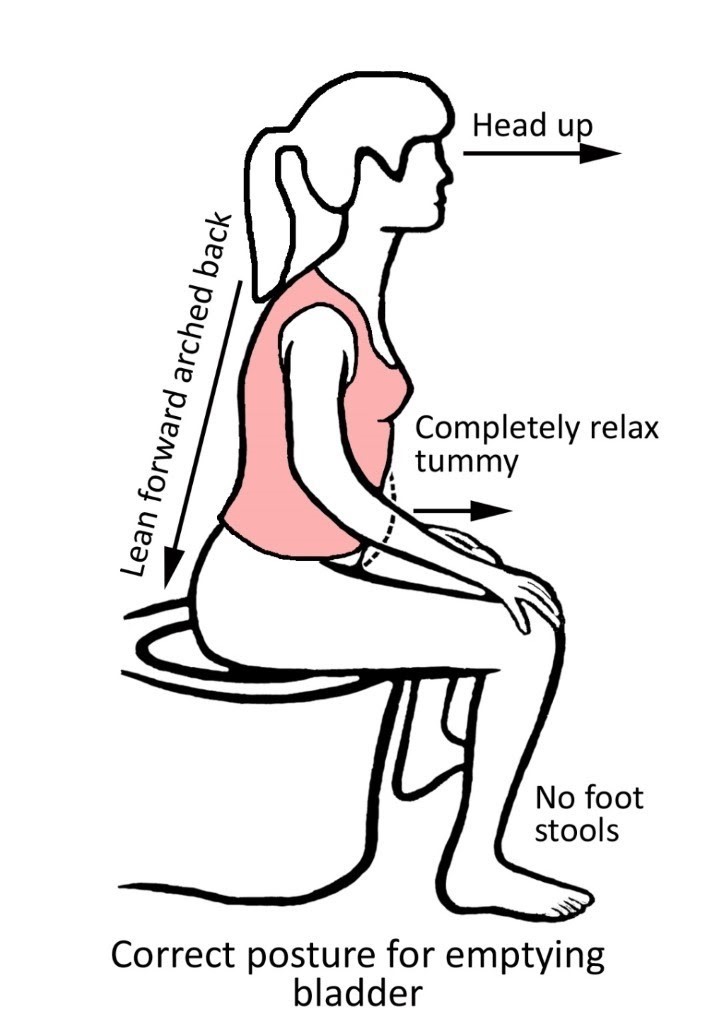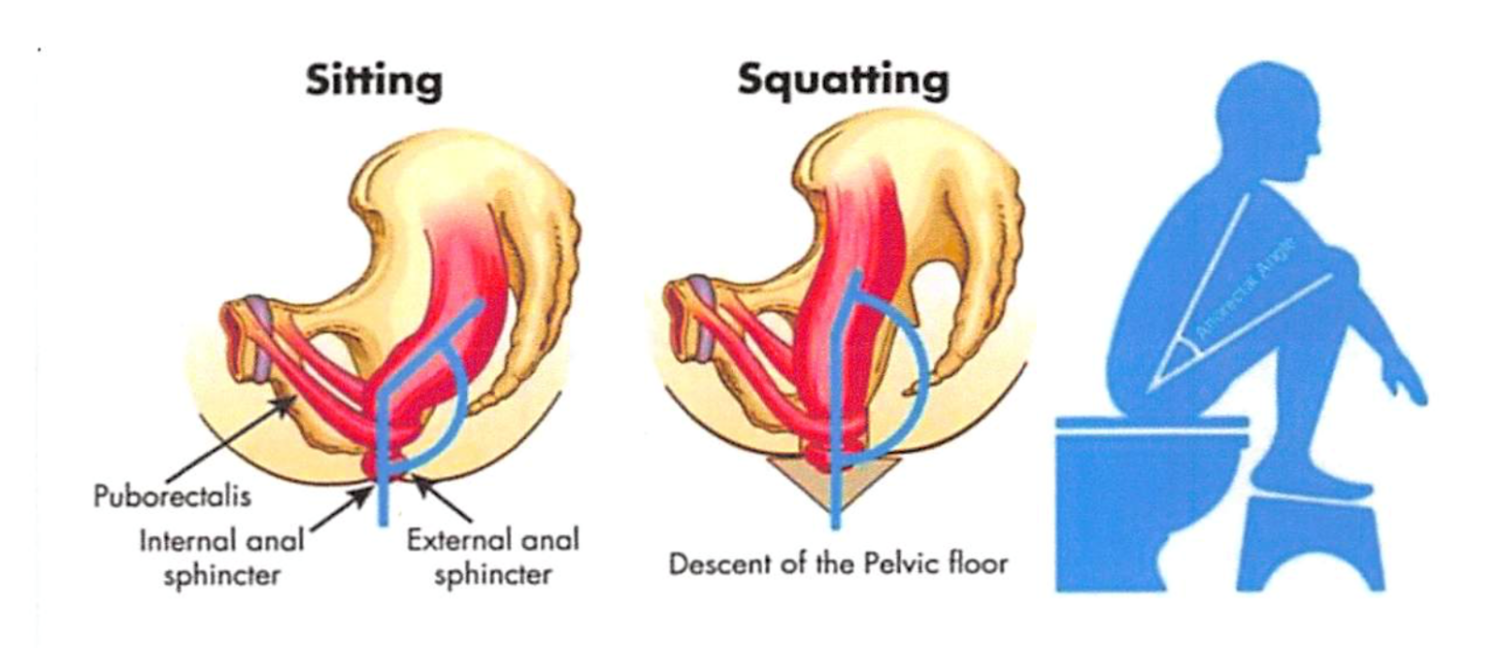You may have thought that as long as things are flowing and going, you have no issues when it comes to proper toilet positioning. We aren’t here to interrupt this process, however those of you who are experiencing any of the following, we have some quick tips to help you out.
- A slower stream of urine
- Stop and go urine stream
- Difficulty fully emptying (includes bladder and bowel side)
- Constipation
- Frequent bathroom trips (includes bladder and bowel side)
There are two to three different toilet positions (three if you have male body parts) that can help reduce the above symptoms.
Toilet Positioning for Urination:


One key point of these two diagrams on urination to focus on is there is a slight lean forward where you can rest your hands on your knees, or even rest your forearms down on your thighs. By leaning forward, you are placing a little more pressure over your bladder (located just behind your pubic bone), and it can create a “milking effect” to aid in voiding. As you assume this position, make sure your back is straight versus rounded. A rounded spine will interrupt the mechanics of maintaining more pressure over your bladder.
Another key point is to relax your belly. This is no time to hold in your abdomen or feel you need to have a flat core. Instead, relaxing your belly and even practicing your belly breathing, where you avoid sending air into your chest and focus on sending it into your lower abdomen, can also help with completely voiding since this relaxes your pelvic floor muscles.
With male body parts, the only difference is the option to stand. We encourage our male patients to try sitting if you have difficulty emptying your bladder. If sitting doesn’t seem to change anything you can also try tilting your pelvis forward (i.e. sticking your bum/tailbone out behind you), and breathing into your abdomen. Doing a little shake to your penis to make sure all the urine traveling from your bladder has exited can also be helpful.
Toilet Positioning for Defecation:

If you’ve ever heard of or seen the delightfully funny commercials advertising the “Squatty Potty,” this is the reason why. By simply placing your feet on something to raise your knees higher than your hips, you are able to straighten out this naturally occurring anorectal angle. Now, we aren’t here to promote this, nor are we getting paid to do so. You can simply use a stool lying around the house, yoga blocks, or stack books up under your feet.
The one thing not shown is that you should have feet apart and not together. This helps to create more movement/relaxation of the pelvic floor.
Once you have assumed this position, begin breathing into your belly. With legs up in the position shown, your belly breathing could result in some pressure of your abdomen into your thighs – this is okay! Actually it can be a nice cue for you to know you’re doing the breathing properly. Again, we are avoiding breathing into our chest and instead are focusing on breath into the lower abdomen. Now you know the best postion to poop on the toilet!
How do you push during a bowel movement?
It is very likely that we have all adopted various methods of pushing (hopefully never straining) during bowel movements. This is a technique, however, that keeps our pelvic floor relaxed so stool can successfully evacuate. However, consistent increases in pressure can lead to prolapse, hemorrhoids, and fissures.
As you continue with your belly breathing, imagine your pelvic floor muscles relaxing down and out toward the toilet below you. When you get the sensation of needing to push, take a big inhale, direct that air into your abdomen; keep your belly “out” as you exhale and gently push down. The main cue we give for this is: “Belly big, belly hard as you push.” The exhale should be audible to make sure you aren’t holding your breath. The reason for this method of pushing is to make sure your pelvic floor is relaxed versus contracted and tight, which causes resistance to stool trying to exit.
For some people, simply changing the way they use the toilet can drastically improve the symptoms mentioned above. For others, however, there is more of an underlying issue with their pelvic floor musculature that needs to be addressed. If you struggle with one of the symptoms mentioned and you have tried the toilet positions but haven’t noticed changes, contact a pelvic floor physical therapist who will be able to assess your pelvic floor and determine an appropriate course of action to improve your bowel and/or bladder habits.

